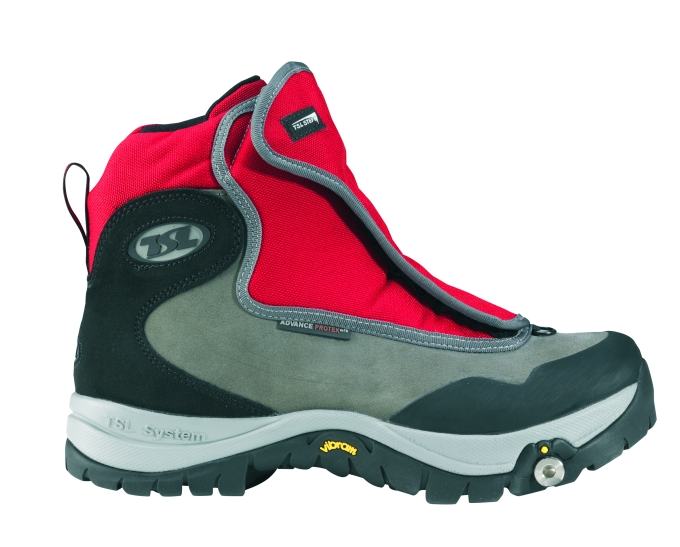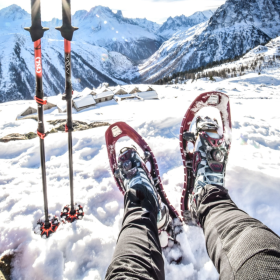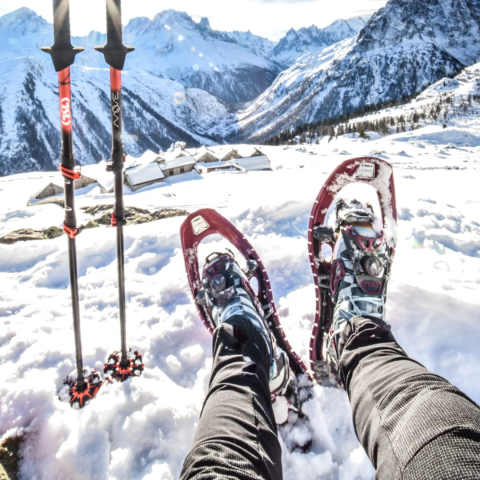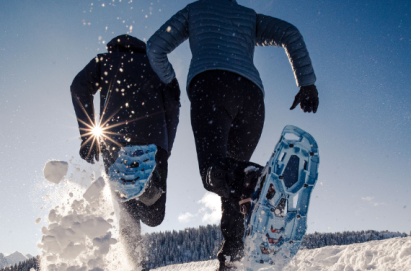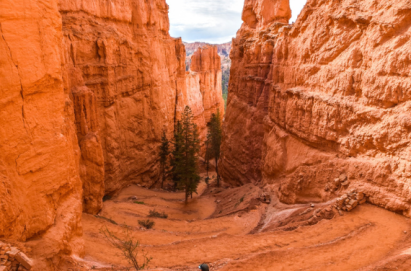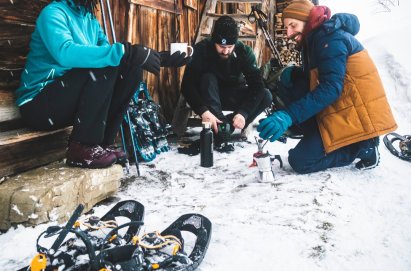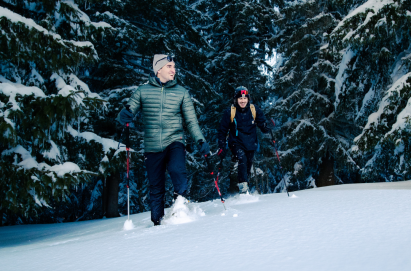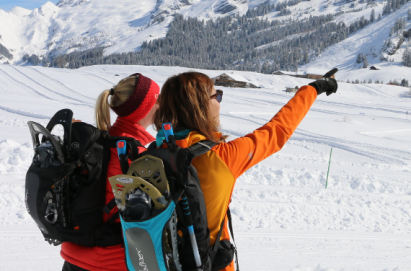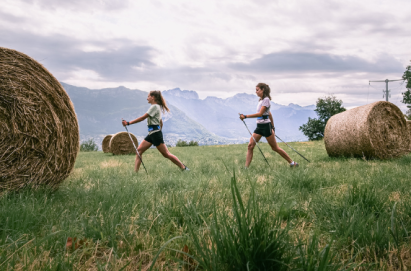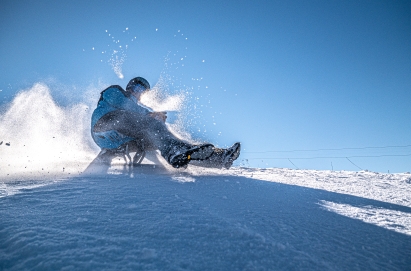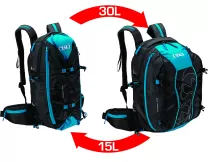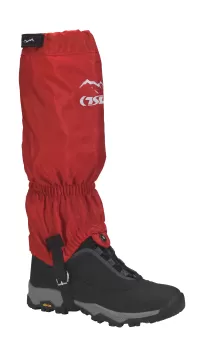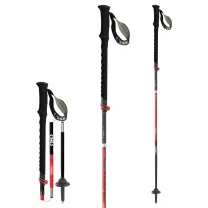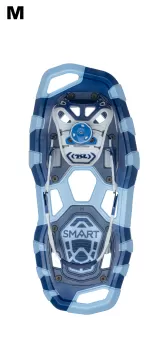
BEST BOOTS & FOOTWEAR FOR SNOWSHOEING
Best Boots & Footwear For Snowshoeing (Winter 2023/24)
Welcome to TSL Outdoor's comprehensive guide for Winter 2023/24 on selecting the perfect snowshoeing boots. When you're venturing into the winter wilderness, having the right footwear is essential to ensure a comfortable and enjoyable snowshoeing experience. In this in-depth guide, we will help you navigate the world of snowshoeing boots, including the different types of boots, the best options for Winter 2023/24, and the crucial features you should look for in your snowshoeing footwear. We'll also explore the accessories that can keep you warmer and drier during your snowy adventures.
You can check out all our snowshoes for men, women and kids on our dedicated selection !
Types of Boots for Snowshoeing
Hiking Boots
Snowshoeing can be an exhilarating experience, and it doesn't always require specialized snowshoeing boots. Hiking boots are a versatile option for snowshoeing. The best winter hiking boots and best hiking boots come in a variety of styles, including low-cut, mid-cut, and high-cut, allowing you to choose the one that best suits your snowshoeing adventures. While they might not have the level of insulation snowshoeing boots have, they can provide the flexibility you need for various terrains. When it comes to snowshoeing, having lightweight hiking boots can also be a game-changer. For added versatility and protection, consider a waterproof boot to keep your feet dry in wet snow conditions.
Insulated Winter Hiking Boots
If you're planning on exploring the backcountry during the winter, insulated winter hiking boots are your best friend. These boots, including insulated boots and winter hiking boots, are designed to keep your feet toasty warm in freezing temperatures. They often feature synthetic or down insulation, which provides exceptional warmth without the bulk. Insulated winter hiking boots and insulated boots strike a balance between warmth and agility, making them perfect for more advanced snowshoers.
Old-Fashioned Winter Boots
Sometimes, going old-school is the way to go. Old-fashioned winter boots, like those your grandparents used, have been keeping feet warm for generations. They might not have all the modern features, but they're tried and true. Ideal for casual snowshoeing adventures, these boots, including a solid winter boot, can provide old-world charm with functional winter protection.
Best Boots for Snowshoeing
Now, let's explore the best snowshoeing boots for Winter 2023/24. We've categorized our recommendations to help you find the perfect fit for your level and style of snowshoeing.
Best for Beginners
Versatile Hiking Boots
- These boots are ideal for newcomers to snowshoeing. They offer decent insulation, traction, and waterproofing, making them a great starting point for your winter adventures.
Insulated Winter Hiking Boots
- Known for their warmth, these boots provide great ankle support and waterproofing, making them perfect for those new to snowshoeing.
Best for Advanced Snowshoes
Technical Snowshoeing Boots
- These boots are built for more experienced snowshoers, offering superior support, traction, and waterproofing. They're ideal for those who love challenging terrains.
Insulated Backcountry Boots
- If you're an advanced snowshoer who craves performance, these boots deliver exceptional durability, warmth, and precision. Conquer the most demanding snowshoeing adventures with ease.
All-Around Favorites
Versatile Winter Boots
- These boots are perfect for a wide range of snowshoeing conditions. They offer excellent insulation and waterproofing, ensuring comfort on long winter outings.
All-Terrain Hiking Boots
- These boots are a popular choice for their versatility and comfort. They provide good support and are suitable for various types of snowshoeing.
What Features to Look for in Snowshoeing Boots
When choosing snowshoeing boots, it's important to consider the following features to ensure they meet your specific needs.
Waterproofing
Waterproofing is a fundamental requirement for snowshoeing boots. Look for boots with quality waterproofing materials, including a waterproof membrane, to prevent moisture from seeping into your boots.
Foot and Ankle Support
Snowshoeing often involves uneven terrain, so proper support and stability are crucial. Look for boots with a supportive shank and ankle protection, especially if you have wide feet
Insulation
Consider the type of insulation that suits your needs. Synthetic insulation or down insulation will determine how warm your feet stay in cold conditions. You want to ensure your feet stay warm and dry and warm and comfortable throughout your snowshoeing adventures.
Comfortable Fit
Comfort is key to a pleasant snowshoeing experience. Ensure your boots are the right size and width, and don't forget to try them on with your snowshoes. Leather uppers can offer both comfort and durability.
Textured Heel
Boots with a textured heel provide better grip on slippery terrain. Look for deep lugs or self-cleaning outsoles for improved traction to prevent wet feet.
Tight Lacing
Different lacing systems can affect the fit of your boots. Experiment with lacing techniques to achieve the perfect fit with a breathable membrane.
Shoe Height
The height of your boots affects their performance. Choose the height that suits your snowshoeing conditions, from low-cut for casual outings to high-cut for deep snow and rugged terrains.
Traction (or Lack Thereof)
While traction is important, excessive traction can be problematic with some snowshoe bindings. Consider the type of snowshoes you'll be using and choose your boot's traction accordingly. A breathable boot is also essential to prevent discomfort.
Accessories for Snowshoeing Boots for Enhanced Warmth and Dryness
Snowshoeing boot accessories can make a big difference in keeping your feet comfortable during your winter adventures. Here are some accessories you might want to consider:
Gaiters to Keep the Snow Out
Gaiters are essential for keeping snow out of your boots. They wrap around your legs and boots, creating a barrier against snow and moisture.
Waterproof Socks to Keep Your Feet Dry
Waterproof socks are a game-changer when it comes to keeping your feet dry. They're designed to keep moisture out while allowing your feet to breathe.
Winter Insoles to Add Warmth and Support
Winter insoles can provide additional warmth and support. Some even have heating elements for extra comfort on extremely cold days.
Thick Wool Socks to Add Warmth
Wool socks are known for their insulating properties. Layering a pair of thick wool socks can keep your feet warm and cozy in freezing temperatures.
Heated Socks for the Ultimate in Warmth
For the ultimate warmth, consider heated socks. These high-tech wonders have built-in heating elements to keep your feet toasty in any weather.
Heated Insoles for Affordable Warmth
If heated socks aren't your style, you can also opt for heated insoles. They're a more budget-friendly option for keeping your feet warm during your snowshoeing adventures.
Ideal Boots for Your Snowshoeing Journey
Your choice of snowshoeing boots should align with your specific snowshoeing goals and the type of terrain you plan to conquer. Here are some detailed recommendations based on different scenarios:
Beginners
If you're new to snowshoeing, the right choice of boots is crucial to ensure a positive first experience. Here's what to look for:
- Comfortable Hiking Boots: A pair of comfortable and waterproof hiking boots is an excellent starting point for beginners. These boots offer a balance between comfort and protection, making them ideal for introductory snowshoeing adventures.
- Waterproofing: Ensure the boots have reliable waterproofing, including a waterproof membrane, to keep your feet dry. Gore-Tex or similar materials are a good choice.
- Light Insulation: Light insulation is sufficient for beginners. Look for boots with basic insulation to keep your feet warm without overheating during your first snowshoeing outings.
- Ankle Support: Pay attention to ankle support. Adequate support will help you maintain stability, especially on uneven terrain.
- Traction: While you don't need excessive traction, make sure the boots have a sole with enough grip to handle slippery conditions.
- Affordable Price: As a beginner, consider a reasonably priced option that meets these criteria. Once you gain more experience, you can invest in specialized boots tailored to your preferences.
- Weight: Consider the weight of the boots as it can impact your comfort and mobility while snowshoeing. Lightweight options are often preferred.
- Mesh: Some boots feature breathable mesh, allowing your feet to stay dry and comfortable.
- Time: Take your time to pick the right pair of boots that suit your needs and budget. Don't rush the decision.
- Impact: Make sure to assess the impact of your choice of boots on your snowshoeing experience.
- Type of Boots: Consider the kind of boots that fit your style and preferences, whether they are hiking boots, snowshoe boots, or casual winter boots. The right pair of boots can make a significant difference in your snowshoeing experience, so choose wisely
- Season: Think about the season when you plan to go snowshoeing, and ensure your boots are suitable for the conditions.
- Outdoor Gear: Your choice of boots should complement your other outdoor gear and clothing for a seamless experience.
- Men and Women: Keep in mind the gender-specific options available for both men and women.
- Buy: When you're ready, make an informed decision and buy the boots that best match your snowshoeing requirements. Pro Tip before you buy: Make sure you try the boots on while sitting and standing to check for a comfortable fit in different positions.
Backcountry Explorers
Venturing into the backcountry during winter requires boots that can withstand extreme conditions and provide the warmth and durability you need. Here's what to consider:
- Insulated Backcountry Boots: For backcountry explorers, insulated backcountry boots are the go-to choice. These boots offer substantial warmth and are designed to withstand harsh conditions.
- High Waterproofing: Ensure your boots have top-notch waterproofing to keep your feet dry even in deep snow or wet backcountry terrain.
- Heavy Insulation: Backcountry boots should feature heavy insulation, such as down or synthetic materials, to keep you warm during long treks in sub-zero temperatures.
- Rugged Construction: Look for boots with a rugged construction that can endure the rigors of the backcountry, including rocky terrain and deep snow.
- High Ankle Support: Given the challenging terrain, opt for boots with high ankle support to reduce the risk of injury.
- Excellent Traction: Your backcountry boots should have an outsole with aggressive traction to provide grip on steep slopes and unpredictable surfaces.
- Invest in Quality: Don't cut corners when it comes to quality. High-quality backcountry boots are an investment that ensures your safety and comfort during demanding winter expeditions.
Casual Snowshoers
For those who enjoy casual snowshoeing adventures in various conditions, versatility and comfort are key. Here's what to look for:
- Versatile Winter Boots: Versatile winter boots are perfect for casual snowshoers. These boots offer a good balance between insulation, comfort, and protection.
- Waterproofing: Ensure your boots have effective waterproofing, including a waterproof membrane, to keep your feet dry during varying winter conditions.
- Moderate Insulation: For casual snowshoers, moderate insulation is usually sufficient. Look for boots with insulation suitable for a range of temperatures.
- Comfortable Fit: Prioritize comfort. These boots should provide a comfortable fit, allowing you to enjoy leisurely snowshoeing without discomfort or blisters.
- Traction: Moderate traction is adequate for casual snowshoeing. The boots should have a sole with enough grip to handle snowy and icy surfaces.
- All-Terrain Design: Choose boots designed for all-terrain use, allowing you to explore a variety of landscapes without switching footwear.
- Affordable Options: Casual snowshoers can find affordable and reliable winter boots that provide everything you need for leisurely snowshoeing. There's no need to break the bank for occasional outings.
- Kind of Boots: Consider the kind of boots that fit your style and preferences, whether they are hiking boots, snowshoe boots, or casual winter boots.
Advanced Snowshoers
Advanced snowshoers require boots that can meet their specific needs in challenging terrains and conditions. Here's what to consider:
- Technical Snowshoeing Boots: Advanced snowshoers should invest in technical snowshoeing boots that are designed for top-tier performance in the snow.
- Specialized Waterproofing: These boots should feature specialized waterproofing, including a waterproof membrane, that goes beyond basic requirements, ensuring your feet remain dry in the harshest conditions.
- Adaptive Insulation: Look for boots with adaptive insulation that can keep your feet warm in extreme cold but also release excess heat when needed.
- Precision Fit: Precision fit is essential for advanced snowshoers. The boots should offer customizable lacing systems and a snug, responsive fit.
- Layer: Layering your socks and considering thermal socks can impact your overall comfort in advanced snowshoeing boots.
- High Ankle Support: Given the challenging terrain and more demanding snowshoeing, choose boots with high ankle support to minimize the risk of injury.
- Advanced Traction: Advanced snowshoers need boots with advanced traction features for tackling steep slopes, deep powder, and technical terrain.
- Quality Investment: Advanced snowshoers should be willing to invest in high-quality boots that meet their specific needs. These boots are a vital part of an advanced winter outdoor kit and ensure a high level of performance. Keep in mind that the price is often per pair of boots, so it's essential to evaluate the value for the investment.
Conclusion
Selecting the right boots for your snowshoeing journey is an essential step towards a successful and enjoyable winter adventure. By understanding your specific snowshoeing goals and choosing the appropriate type of boots, you can enhance your comfort, safety, and overall experience in the snowy wilderness. Remember that your boots are your most trusted companions during your snowshoeing excursions, so choose wisely and embark on your winter adventures with confidence.
FAQ
-
What kind of boots do you wear for snowshoeing?
For snowshoeing, it's crucial to wear insulated, waterproof boots with good ankle support. Look for boots designed for winter activities, featuring a durable and water-resistant outer layer, insulation for warmth, and a sturdy sole for traction in snow. Boots that are compatible with snowshoe bindings and provide comfort during long treks in cold conditions are ideal.
-
Are snowboard boots good for snowshoeing?
While snowboard boots provide excellent warmth and ankle support, they may not be the ideal choice for snowshoeing due to their stiffness. Snowshoeing demands more flexibility for natural walking and varied terrain. It's recommended to opt for winter hiking boots with insulation, waterproofing, and a design that accommodates the movement needed for snowshoeing. These boots offer a balance between warmth, comfort, and mobility during your snowshoe adventures.
Discover our latest news
